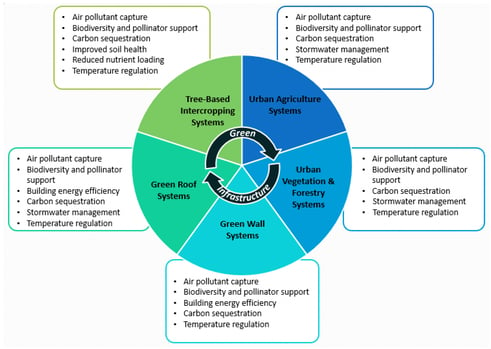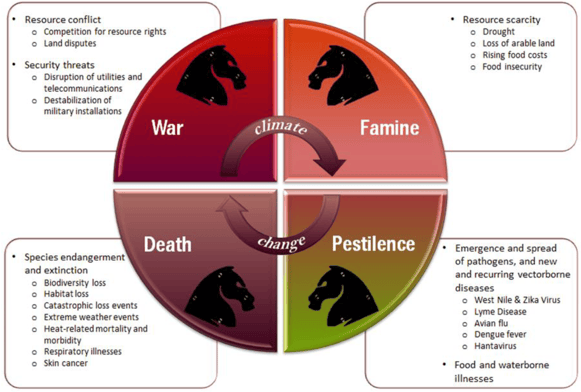We live in a time when the impacts of climate change are beginning to be felt more regularly. Intense weather events, such as droughts or floods, as well as wildfires and pollution, have become a part of the everyday news cycle and must be addressed – not with fear and panic, but through harnessing knowledge and applying prevention and mitigation techniques. According to Filazzola et al., research data indicates that we should encourage policymakers and practitioners to improve the design of green infrastructure to benefit urban ecosystems because of the potential benefits for both humans and global biodiversity (1).
A scientific study, entitled Harnessing the Four Horsemen of Climate Change: A Framework for Deep Resilience, Decarbonization, and Planetary Health in Ontario, Canada by Anderson et al., 2021, addresses the role of green infrastructure to build a world that can be better prepared to deal with the pressures that can become a part of our future reality. The authors deconstruct the threats according to the analogy of the biblical four horsemen of the apocalypse to organise a framework of sustainable solutions and/or prevention mechanisms based on green infrastructure (2).

Green infrastructure form and function. Image sorce: Anderson, Vidya, and William A. Gough. 2021.
According to the authors Anderson et al. (2012), climate change is a threat multiplier that can affect critical socioeconomic factors through damage to transportation systems, have an impact on food access and distribution, the movement of goods and services, energy production, employment and overall security risks through exacerbating civil unrest, population displacement and disruption of livelihoods. In contrast, the implementation of green infrastructure has multiple environmental and health co-benefits for communities (2).
In their paper, the War category represents resource conflict, connected to competition for resource rights and land disputes, as well as security threats caused by disruption of utilities and telecommunications, civil unrest, population displacement and the destabilisation of military installations. Flooding, in particular, poses a major risk to infrastructure. Green infrastructure can help by providing stormwater storage during strong rain events to reduce flood risk, prevent erosion, control runoff and reduce pollution. This is done by holding water in its growing medium until it drains slowly and/or evapotranspires back into the atmosphere. The application of a green roof can reduce stormwater runoff and flooding from 50 to 100 per cent depending on the depth of the substrate, roof slope and plant species (2).
A study by Song et. al. (2023) illustrates this using a case study set in Korea, where nearly 90% of the natural disasters occurring over the past decade involve floods attributed to heavy rains and typhoons. They also stress that a flood occurring in the coastal regions affects the ability of the social and environmental systems to manage the recovery process over the long term. Their work studies in the ability of green infrastructure to mitigate the effects of water stress in proposed disaster scenarios based on Typhoon Chaba. They found that green infrastructure (green roofs, infiltration storage facilities, porous pavements) could significantly reduce and delay the amount of runoff flowing into treatment facilities by reducing the peak discharge and delaying runoff. In the case of the green roof, the effect was the greatest after 6 h following the typhoon passing through (1). Therefore, green infrastructure can contribute to a better capacity for responding to extreme weather events. It can also reduce and prevent service interruptions, damage, and property loss, reduce impacts on the local economy from utility and infrastructure disruptions caused by flooding and increase the resilience of critical infrastructure, contributing to overall stability (2).
The Famine category includes the risks associated with rising food costs and food insecurity. Weather variability, and extreme weather events such as droughts and flooding impact food supply and access, and the loss of arable land and viable fisheries from flooding and coastal erosion add to its negative effects. Food security is further impacted by escalating food prices. Here, urban agriculture systems can be used to reduce the food miles and carbon footprint associated with conventional agriculture. Local food production would also mean better food availability and security. Urban agriculture systems also provide key ecosystem services including stormwater management. It has been shown to enhance insect and vertebrate diversity and to provide pollinator-friendly habitats (2).

The Four Horsemen of climate change—categories of climate change impacts, war, death, famine, and pestilence. Image source: Anderson, Vidya, and William A. Gough. 2021.
The Pestilence category covers the emergence and spread of pathogens and vector-borne diseases. Warmer summers and shorter winters can contribute to the spread of diseases carried by ticks and mosquitos, like the West Nile virus, Zika virus and Lyme disease. The risk of avian flu, dengue fever and hantavirus is also increased, as well as the possibility of food and waterborne illnesses. Rising temperatures are directly linked to an increased risk of disease when groundwater, surface water or other drinking water sources are contaminated by flooding. Warmer and wetter conditions are favourable to the growth of bacterial pathogens. Within urbanized areas, we also come across multiple air pollutants. Pollution is another pressing issue. Ground-level ozone and nitrogen dioxide can cause lung inflammation and reduced lung capacity, as well as worsen pre-existing health conditions such as asthma and bronchitis. Ozone can also irritate the eyes and nose. Through the management of stormwater, green infrastructure such as green roofing, urban vegetation, and forestry can reduce surface water run-off during rainfall and thus reduce and prevent the spread of pathogens, contamination of water bodies and the spread of water-borne diseases. It can also regulate rising temperatures through evapotranspiration and shade provision. Studies have also shown that the application of green infrastructure can remove air pollutants including ozone, nitrogen dioxide, and particulate matter (2).
The Death category refers to species endangerment, biodiversity loss, habitat loss and extinction, catastrophic and extreme weather events, heat-related mortality and morbidity, respiratory illnesses and skin cancer. In addition, people who are older, chronically ill, and socially disadvantaged are more vulnerable to the health effects of extreme heat which can include serious illness and even death. To combat that, green infrastructure has a moderating effect on temperature through a cooling effect on its environment that helps reduce the urban heat island effect. Green infrastructure has been shown to improve health outcomes from extreme heat and reduce air pollutant concentrations by acting as a filter for particles (2). As explained by Filazzola et al., the development of buildings and other infrastructure in cities is often viewed as a threat to local biodiversity and ecosystem functioning because the natural habitat is replaced. However, green infrastructure such as green roofs, wetland detention basins and community gardens can partially offset these impacts. Their meta-study examined 33 research papers has determined that green infrastructure significantly improves biodiversity over conventional infrastructure equivalents and that in some cases had comparable measures of biodiversity to natural counterparts (1). Multiple green infrastructure applications can also create a network of spaces acting as wildlife habitats and enhance the capacity of natural areas to respond to climate change, thus helping to maintain and increase the biodiversity of both aquatic and terrestrial ecosystems (2).
Even though our planet’s future sometimes seems bleak, it is also full of hope. We look forward to working towards the greater implementation of green infrastructure in the future!
- Filazzola, A, Shrestha, N, MacIvor, JS. The contribution of constructed green infrastructure to urban biodiversity: A synthesis and meta-analysis. J Appl Ecol. 2019; 56: 2131– 2143. https://doi.org/10.1111/1365-2664.13475
- Anderson, Vidya, and William A. Gough. 2021. "Harnessing the Four Horsemen of Climate Change: A Framework for Deep Resilience, Decarbonization, and Planetary Health in Ontario, Canada" Sustainability13, no. 1: 379.
- Song, Kihwan, Youngsun Seok, and Jinhyung Chon. 2023. "Nature-Based Restoration Simulation for Disaster-Prone Coastal Area Using Green Infrastructure Effect" International Journal of Environmental Research and Public Health20, no. 4: 3096. https://doi.org/10.3390/ijerph20043096


